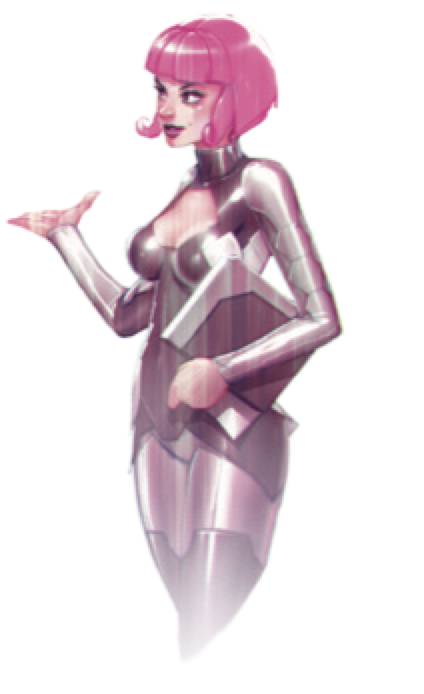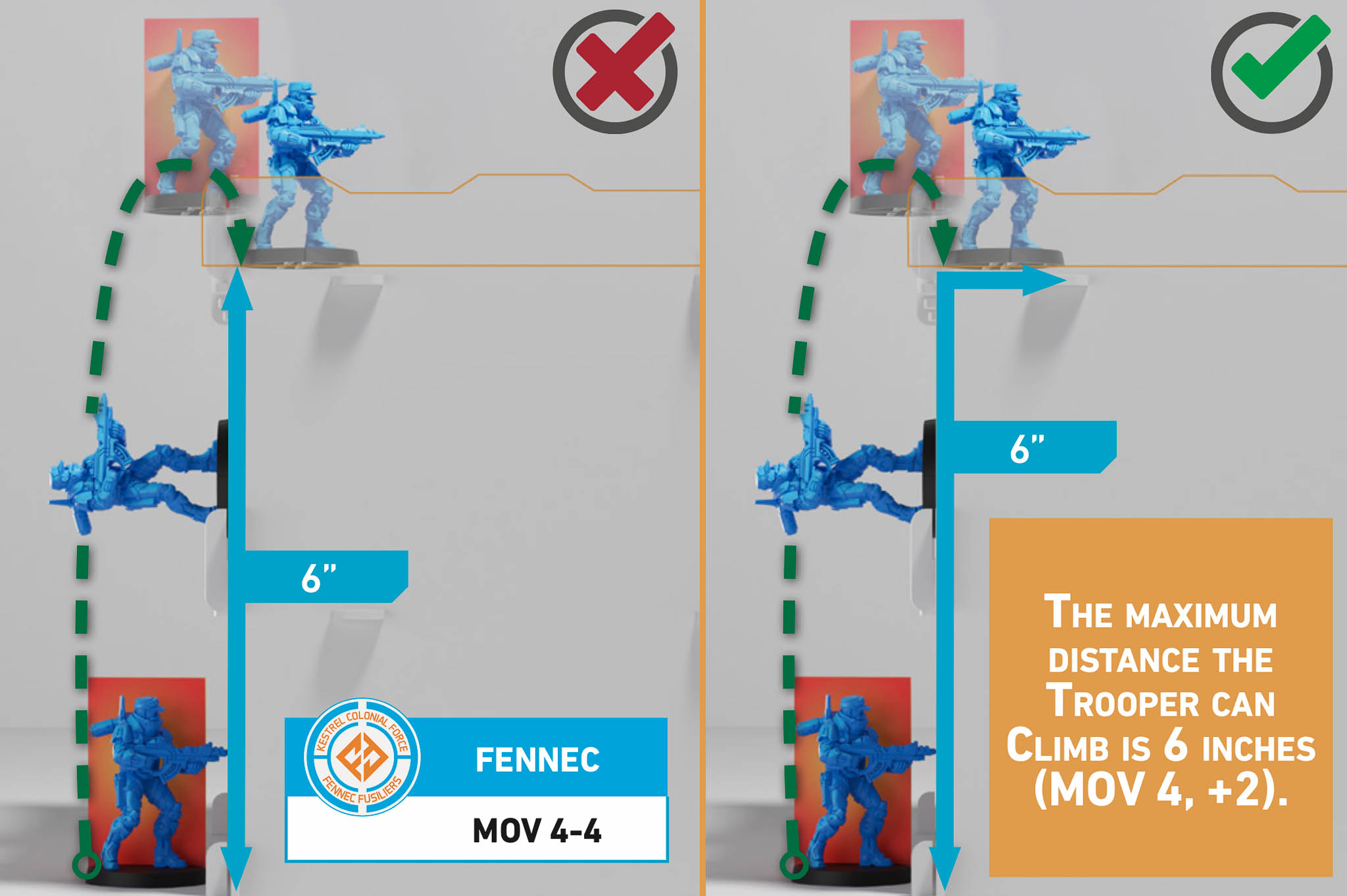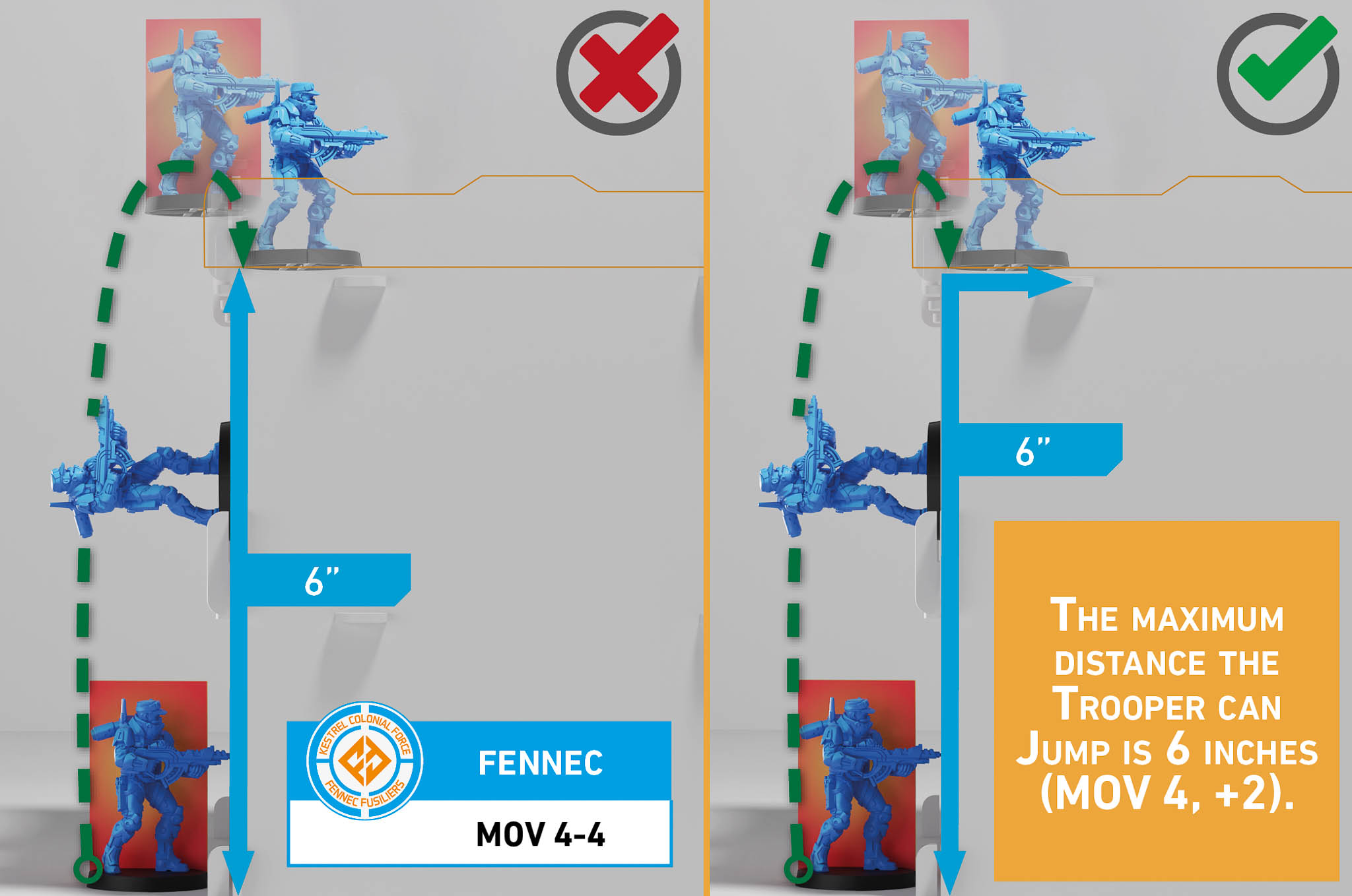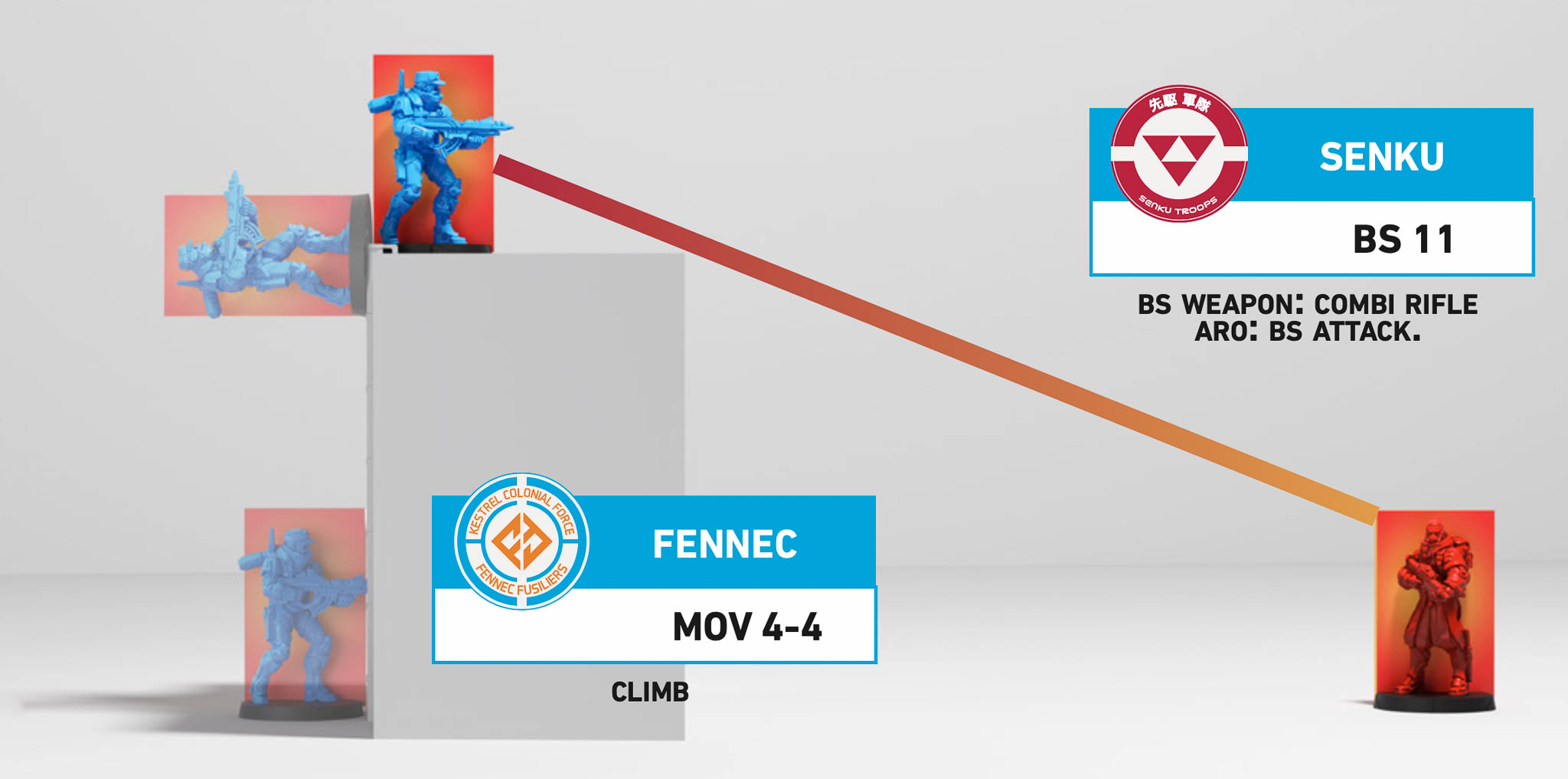NOTICE: Infinity N5.2 and N5 FAQ 0.0.0
The wiki has been updated to include the N5.2 changes and the v0.0.0 FAQ.
List of wiki pages updated in N5.2.
Climb
Alert | BS Attack | Cautious Movement | CC Attack | Climb | Discover | Dodge | Idle | Intuitive Attack | Jump | Move | Look Out | Place Deployable | Reload | Request Speedball | Reset | Speculative Attack | Suppressive Fire
This Common Skill allows the user to climb and move on vertical surfaces.
Players must check the Requirements of this Skill when declaring it.
- The Trooper’s base must be in contact with a vertical surface.
- At least half the Trooper’s base must stay in contact with the surface on which they are moving.
- The Trooper must be able to finish their movement on a surface that is equal to or larger than their base.
- Allows the Trooper to move on a vertical surface. The user can Climb up to the first value of their MOV Attribute, plus 2 inches.
- Climbing is a Common Skill that does not require a Roll.
- When Climbing, players must measure the distance from the starting point to the destination, measuring from the base's outer edge and underside.
- For visualization purposes, Troopers using the Climb Skill move with at least half of their base's underside in contact with the vertical surface.
- Climb only allows movement on vertical surfaces. The Climb Skill does not allow the user to move on a horizontal surface, even if their modified MOV value exceeds the distance that needs to be Climbed. Therefore, a Trooper will finish their Climbing movement the moment the whole of their base in contact with a horizontal surface (see Example 1).
- Climbing movement must follow the General Movement Rules as well as the Moving and Measuring rules.
- Some Troopers have the Climb Skill listed in their Unit Profile with a distance shown in round brackets. When Climbing, the Trooper can add this distance to their Climb, instead of 2 inches.
- Troopers cannot be deployed on a vertical surface, neither during the Deployment Phase nor during the game.
- As long as a Trooper is holding on to a vertical surface, they cannot declare any Skills other than Climb.
- A Trooper who is Climbing or holding onto a vertical surface and becomes Unconscious will place the corresponding State Token beside them as usual. Even while climbing, Unconscious Troopers are still in Prone State, except for those Unit Types that cannot enter Prone State.
Update PDF 5.2, October 2025
- A Trooper who is on a vertical surface cannot benefit from Partial Cover MODs.
Show original text.
Original
- A Trooper who is Climbing or holding onto a vertical surface cannot benefit from Partial Cover MODs.
A Trooper in the Reactive Turn who is holding onto a vertical surface cannot declare an ARO. The reason for this is that, while on a vertical surface, the only available Skill is Climb, and Climb is a Long Skill that cannot be used in the Reactive Turn.
Any height on the game table that is higher than the height of a Trooper's Silhouette Template determined by the Trooper's Silhouette Attribute requires declaring the Jump or Climb Common Skills to pass it.

Before the game begins, it is a good idea for both players to agree on which surfaces on the game table will require the use of the Climb Skill, taking into account potentially dubious cases, such as buildings with slightly angled walls.
- With this Special Skill, the Climb Long Skill is turned into a Basic Short Skill, if declared as the first Basic Short Skill of the Order.
- Climbing Plus also allows the user to move on vertical surfaces as if performing normal Movement on a horizontal surface when declaring Move or Dodge, or during movement due to a failed Guts Roll. The General Movement Rules and Moving and Measuring chapter must be applied.
- The Climbing Plus Special Skill allows its user to perform other Basic Short Skills or Short Skills (e.g. Move + BS Attack) while moving on a vertical surface, or if hanging from a height (see Trooper Activation).
| Restrictions Chart |
|---|
| Troopers mounted on Motorcycles cannot go Prone, declare Cautious Movement, Climb, use ladders, or perform an upwards Jump. |
Examples
Update PDF 5.2, October 2025

Show original text.
Original

A Trooper that is in Silhouette contact with an obstacle declares the Climb Skill. When measuring, the player finds that the distance the Trooper needs to Climb is shorter than the maximum distance for this Skill (6 inches= their first MOV value of 4, + 2 inches = 6 inches). Hence, it is enough to Climb the obstacle and move onto its upper surface. Even though the 6 inches granted by the Climb Skill exceeds the distance that needs to be Climbed, the Trooper must finish their movement as soon as the whole of their base is in contact with the upper surface of the obstacle.

A Trooper spends an Order and declares the Move Skill until they reach base contact with an obstacle. With a second Order, they declare the Climb Skill, check that the 6 inches granted by this Skill (their first MOV value of 4, + 2 inches) are enough to move onto the upper surface of the obstacle, and then finish their movement on the horizontal surface.
Next, the player spends a third Order to Move to the edge of the obstacle. Since they see no enemies and there is no ARO to their Move, their Order's second Skill will be an Idle. To descend on the other side, they declare the Climb Skill again, measure the height of the obstacle, and find that the height of this side of the obstacle is greater than the 6 inches granted by Climb. Therefore, the player needs to spend another Order to finish the Climb and reach the bottom.
Remember that a Trooper will end their Climb movement the moment the whole of their base is in contact with a horizontal surface. If the player decides at some point not to spend any more Orders on a climbing Trooper, they will remain in the position they are in until more Orders are spent on them, or until they enter Dead State.
Update PDF 5.2, October 2025

A Trooper declares the Climb Skill and moves until they are on the horizontal surface. At that moment, an enemy Trooper gains LoF to the Active Trooper and declares a BS Attack ARO. Although the enemy cannot fully see the Active Trooper, they do not apply MODs for Partial Cover since their target is performing the Climb Skill so cannot benefit from Partial Cover MODs.
FAQs
Q: Can you vault while Climbing or Jumping?
A: Yes. Climb and Jump follow the General Movement Rules, including vaulting.
Related Pages: Climb, Climbing Plus, General Movement Rules, Jump, Super-Jump
Alert | BS Attack | Cautious Movement | CC Attack | Climb | Discover | Dodge | Idle | Intuitive Attack | Jump | Move | Look Out | Place Deployable | Reload | Request Speedball | Reset | Speculative Attack | Suppressive Fire